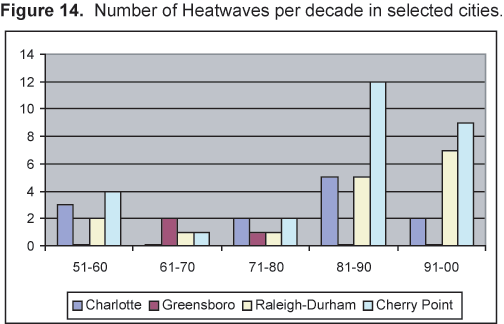Everybody knows that heat waves are extended periods when temperature and humidity are high throughout the day and it doesn't cool down much at night. Beyond that, there is no definition, meteorological or legal, of how extended the periods have to be, or how hot and humid it has to get before a heat wave is said to have occurred. So it is difficult to indicate when one actually occurs, let alone realistically examine trends. Nevertheless, the National Weather Service has some criteria for issuing health-related heat stress warnings that can be used as a guide. These warnings use the Heat Index, a combination of temperature and humidity measurements which approximately represent how hot it actually feels - assuming that one is lightly clothed and doing only light work in the shade. The Index is actually expressed as a temperature. Two consecutive days when the daytime values exceeds 105 and the night does not dip below 80 are the criteria, the heat wave actually starting on the second day. Raleigh met such criteria on 22-24 July, 1998. Not since 1952 had there been such an intense and prolonged hot and humid spell. In the intervening years air conditioning has become much more common and this helped many people survive without too much stress. But it is suspected that the sudden change between indoor and outside conditions may have increased the physical stress for many people. There were numerous cases of health problems, including a few fatalities directly associated with the heat.

There are very few stations in North Carolina with long-term records of both temperature and humidity, so that it is difficult to judge the frequency of heat waves or even how big an area they cover when the do occur. The 1998 heat wave was centered on Raleigh, and probably extended across most of the Coastal Plain. It certainly reached the Marine Corps Air Station at Cherry Point, inland of Morehead City towards New Bern, the only other long-term observing station in the area. It does not seem to have reached the coastline itself. Indeed, the shorter record at Wilmington suggests that the almost perpetual breezes blowing off the ocean cool things off somewhat.
Also, the 1998 event did not go westward as far as Greensboro or Charlotte. Both of these cities are at a higher altitude than Raleigh, and slightly cooler. They were both certainly hot and humid, but not sufficiently hot and humid to meet the National Weather Service heat wave criteria. From the rather scanty records available, it appears that the Coastal Plain, represented by the Cherry Point observations, is the area most prone to heat waves. During the 1950s through 1970s there was little difference between the Coastal Plain and the Piedmont in frequency, but in the last two decades of the 20th century they have become much more prevalent on the Coastal Plain (Figure 14). This may be the result of a recent, and very minor, temperature or humidity increase there, since the National Weather Service criteria seem to put North Carolina right on the border between having a heat wave or not. Small differences in conditions then have a seemingly great consequence in the number of heat waves. Rarely do Raleigh, Greensboro and Charlotte record heat waves at the same time. Sometimes it seems that extra warmth caused by Charlotte's more southerly position is most important, at other times its location at a relatively high altitude seems to be the key. In general, the Piedmont in the 1950s through the '70s had one or perhaps two heat waves per decade, and the Coastal Plain not many more. In the 1980s the number increased substantially, particularly on the Coastal Plain. Now Cherry Point seems to dominate, with Raleigh a clear second. The only station in the mountains having long records of temperature and humidity is in Asheville. No heat wave as defined here has ever been recorded there.